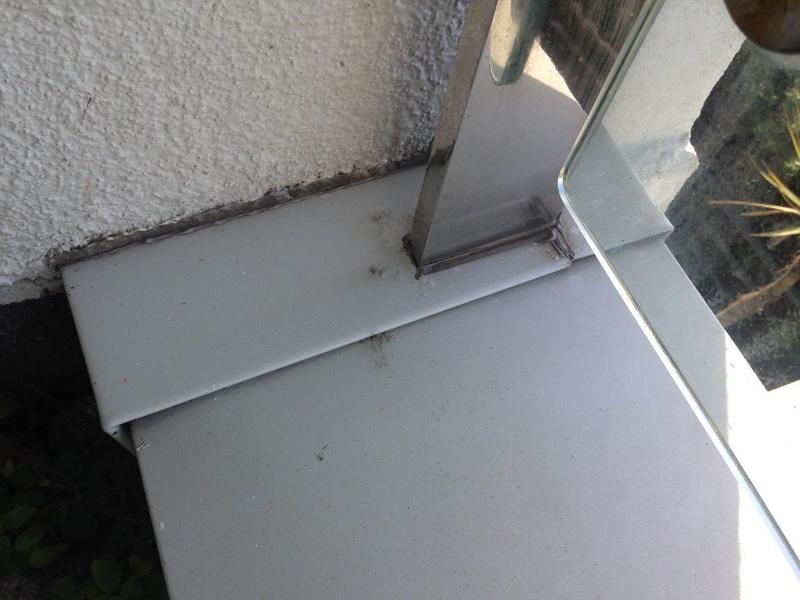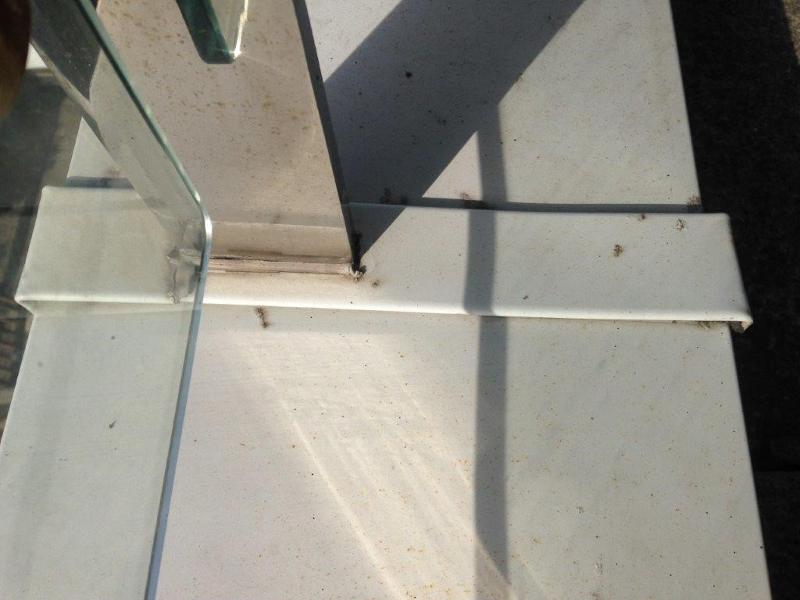Method Statements
Balcony repairs
Sto render repairs
Single Ply Roof repairs
Balcony repairs
• If there is a leak from a balcony, we should seek advice David Brown
• If it is recommended that a new membrane is required, we have it done
• It should be emphasised that the new membrane must be dressed up as far as possible behind the capping without removing the capping– see photo
If it is thought that the joints in the capping, around the posts, have failed (highly unlikely) that should be addressed as a separate issue.
Specification for re-sealing the joints in the capping
• Stiff brush the joint. Do not scrape
• Clean area with White Spirit
• Wipe away excess and allow the White Spirit to dry.
• Apply masking tape to areas close to joint, as necessary.
• Very sparingly, brush joint with suitable Dow Corning primer. Allow to dry.
• Force “Geocel-The Works Clear Sealant and Adhesive” into joint and create visually acceptable finish http://www.geocel.co.uk/images/uploads/data-sheets-pdfs/geocel_the_works_tds_march_2017_data_sheet_st11.pdf
• Clean off excess.
• Repaint with two top coats of Dulux RAL 7038 Agate Grey (matt/satin/gloss?)
Lifting the capping should be a last resort and only done if it can be guaranteed they can be refitted, like for like and requires the specific written approval from the Managing Agents,
The capping is removable but needs to be done very carefully please do not go at it with a crowbar
All work on balconies must be logged on the GSP Balcony Spread Sheet (Serena)
Capping badly damaged


Single Ply Roof Repairs
In 2015 some repairs were made to the single ply roof covering using Triflex system. These repairs subsequently failed.
In 2023
https://www.sussexasphalte.co.uk/ have made several repairs using
https://www.proteuswaterproofing.co.uk/
Sto render
- The Scratch Coat/Dubbing Coat is traditional sand and cement render on to brickwork
- Over Skimmed with STO Armat Classic With Mesh.
- Finished with STO Stolit K
- All fire rated as non-combustible, A2-s1, d0
Method Statement for the repair of Minor Cracks in StoRend External Render Systems
Material Requirements Primer: StoPrim Micro Filling Material: Sto Crack Filler Fine Decorative Finish: Stolit / StoSilco / StoLotusan (depending on original specification) Facade Paint (if required): StoColor MaxiCryl / StoSilco Color / StoLotusan Color
Before repairs are carried out, it is strongly advised that the cause of cracking be identified and the substrate permanently stabilised.
Repair Procedure The following procedures relate to isolated crack repairs in StoRend Systems. 1. Rake out cracks using a craft knife or other sharp implement, undercutting the edges to create a ‘dovetailed’ recess. 2. Remove all loose and friable material by means of vacuum & soft bristled brush. Wash out if necessary and allow to dry. 3. Apply StoPrim Micro (mixed precisely in the ratio of 1:4 with clean water) directly into the crack using a soft bristled brush to provide a hydrophobic barrier. Allow to dry. 4. Within not more than 7 days (preferably after 24 hours) of application of the StoPrim Micro, using a filling knife, spatula or similar small tool, apply Sto Crack
Filler Fine into the open crack, pressing in firmly to ensure the crack is fully filled. Finish by stippling with a small brush to create a texture to match the existing. 5. If some of the render finish from the original application has been retained, then some of the liquid binder (material passed through a sieve to remove the aggregate) may be applied by brush using a stippled action, onto the repaired area to achieve a close colour match. 6. Should the original material not be available, or the new repair does not ‘blend-in’ with the older, weathered surrounding material, then the entire panel / facade should be cleaned and overpainted with a compatible Sto facade paint, tinted either to the colour of the existing render, or any other colour in the StoColor range should a change be required.
Refer to the Sto Technical Data Sheets and Material Safety Data Sheets for the above products for further information and guidance on the application and use of specific products.
Refer to the ‘StoRend Systems – Maintenance & Repair’ document for further information on larger scale repairs and overpainting of facades.
Insa Rend Ltd who carried out repairs to the render on the Camelford Street wall in 2021 used Parex Maite a product that can be applied directly to face brickwork and to a thickness of 4mm to 20mm

|
Sto Method Statement for repairs to Minor Cracks 10_13.pdf Size : 54.483 Kb Type : pdf |
